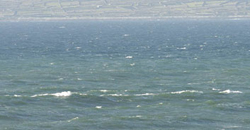THE public disagreement between two State bodies regarding the proposed fish farm off the North Clare Coast is “a very poor reflection of the public sector”, the head of one of them has admitted.
Inland Fisheries Ireland and Bord Iascaigh Mhara have come out on opposite sides of the plan by BIM for the development of a 456-hectare organic salmon farm between the North Clare coast and Inis Oirr.
BIM submitted an application for the farm, which would produce 15,000 tonnes of salmon per year, to the Minister for Agriculture, Food and Marine last January.
Speaking to The Clare Champion Bord Iascaigh Mhara CEO Jason Wholly described the disagreement between BIM and IFI as beyond unseemly. “Unseemly is putting it mildly and it shouldn’t be the case and it is a very poor reflection of the public sector in Ireland and, indeed, the Government that this is the case,” he stated.
A key area of disagreement between the two sides is the threat sea lice might pose to wild salmon. Inland Fisheries Ireland has expressed concern in relation to the location and scale of the proposed fish farm in Galway Bay and how its development and operation would impact wild salmon and sea trout stocks and their habitat.
It also submitted that “the recognised negative impacts of sea lice on salmonids have not been adequately dealt with in the Environmental Impact Statement (EIS) or the associated Natura Impact Statement (NIS). Recent findings show sea lice to have devastating effects on wild salmon, accounting for up to 39% of salmon mortalities.”
IFI states “There is compelling international evidence to show that escaped farmed salmon pose a high risk to wild salmon populations. Negative effects include both ecological interaction and the genetic impacts of inter-breeding.”
Figures used in the BIM EIS were questioned in a study published in the Journal of Fish Diseases this summer.
The EIS for the proposed farm used a 2011 study, which says sea lice infestation of outwardly migrating salmon smolts “was only a minor component of the overall marine mortality in the stocks studied”.
The new scientific paper identifies what it said was “three fundamental methodological errors” in the original study. The publication states that whereas researchers in the study quoted in the EIS “assert that sea lice cause 1% of mortality in Atlantic salmon, the correct estimate is actually a one third loss of overall adult recruitment”.
This week, the European Commission announced that it would re-open its investigation into the impact of sea lice on wild salmon.
A statement released by BIM said it “remains confident that the scientists from the MI (Marine Institute) will successfully defend its scientific findings on this issue and further remains fully confident that the basis for our EIS, with regard to the proposed salmon farm in Galway Bay, also remains valid”.
“I don’t discount for a second that it is apparent to the general public that, on the issue of sea lice, there appears to be contradictory facts or opinions but the facts on both sides of the sea lice argument are the same,” Mr Wholly told The Clare Champion.
“The point we are making, and the Marine Institute are making, about sea lice is that they are a minor and irregular component of smolt or adult salmon mortality is an absolute fact of migrating salmon. What the other scientists are saying is that one fish, if it had gone up the river, would have a significant impact and it is an interpretation of the 1% mortality. It is nothing more than that. It is very difficult to explain. It is very difficult to summarise for an ordinary person listening to that argument, very confusing and, in many people’s eyes, deliberately so,” he added.
BIM submitted a lengthy editorial from Mr Wholly (see page 4) to a number of media outlets recently claiming that credence was being given to “a small cadre of people with a particular sectoral interest, using fair means and foul, to block the creation of much-needed jobs in today’s Ireland”.
When asked about the “foul” means in question, Mr Wholly claimed some people who are against the development of the farm are “deliberately” misleading the public with “false” information.
“As a State organisation, we are limited to putting forward facts in our arguments and I think some of the opposition groups have been putting forward non-facts and in doing so scaring people, deliberately with a view to generating as much unrest and concern in the local community as possible. We can see that that kind of trend is out there and our concern, as an organisation and my concern, as CEO of the organisation, is that where there are genuine concerns for individuals at a community level, that we try to address those. But there are other issues that are being put out there that we just know to be false and we know that the facts will not be taken on board, today, tomorrow or ever by those individuals,” he added.
“I mean, we have people who say that there are pesticides used in salmon farming. That is complete and utter rubbish. There are people going out there publicly and on the airwaves saying farmed salmon is unsafe to eat and that is absolute rubbish when the Food Safety Authority of Ireland would say we should be eating farmed salmon and other oily fish once or twice per week. So that is complete contradiction of fact. So coming on and saying that there is going to be some kind of pollution, or environmental catastrophe, or pesticides, or that this fish is unsafe to eat is completely false. It is a complete contradiction to all the facts of the experts that are out there. That is what I am talking about,” he added.


